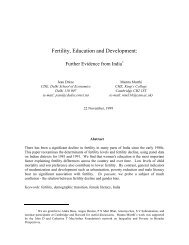Create successful ePaper yourself
Turn your PDF publications into a flip-book with our unique Google optimized e-Paper software.
Along with the clearances for his capital issues, Dhirubhai also had an easy time from<br />
the revenue side of the Finance Ministry. At no stage did Reliance ever pay corporate<br />
income tax on its profits, or even feel the need to make more than token provision<br />
for it. Constant expansion and heavy borrowing gave ever increasing cost deductions<br />
to offset against profits. Reliance became the most famous of India’s ‘zero-tax’s<br />
companies.<br />
In his budget for 1983-84, Mukherjee made one of the government’s periodic efforts<br />
to crack down on such companies, by introducing an amendment to the income tax<br />
law requiring companies to pay 30 per cent of profits in tax after depreciation but<br />
before other deductions. Reliance avoided this by capitalising future interest payable<br />
on borrowings for its new projects, hugely increasing its asset value in one hit and<br />
allowing greatly increased depreciation claims to deduct from profits. Reliance<br />
remained a zero-tax company for nearly three decades after its listing. It was only in<br />
1996-97, after the introduction of a 12 per cent ‘, minimum alternate tax’s on<br />
company profits, that it made its first corporate income tax provision.<br />
<strong>The</strong> collectors of indirect taxes were also friendly. While Reliance could not avoid the<br />
heavy domestic excise duties levied on manufactures at the factory gate, it was<br />
initially given considerable leeway in setting aside some production as ‘wastage’s not<br />
incurring excise. Bombay Customs accepted a 20 per cent to 23 per cent ‘bulk<br />
buyer’s discount given to Reliance by Japan’s Asahi Chemicals up to 1982, and a 7<br />
per cent discount on its purified terephtbalic acid imports thereafter, whereas in<br />
other cases they might have inquired about under-invoicing.<br />
Many officials in charge of customs and excise were drawn into the Reliance family,<br />
rather than adopting the attitude of arms-length enforcers. <strong>The</strong> journalist Kanti Bhatt<br />
recalls attending the marriage of Dhirubhai’s daughter Dipti in 1983, when he joined<br />
the marriage procession, which in the Hindu tradition follows the groom to the<br />
venue, with the guests occasionally breaking into the twirling dance known as<br />
dandya raas.<br />
‘I found myself in the street playing dandiya raas with the Finance Ministry’s chief<br />
enforcement officer,’s Bhatt said.For his investors, all this added up to greater profits<br />
at Reliance, which multiplied from Rs 82.1 million in 1979 to Rs 713.4 million in 1985<br />
(8.69 times), on sales that rose from Rs 1.55 billion to Rs 7.11 billion (4.58 times)<br />
over the same years. <strong>The</strong> company was never India’s most profitable, either in<br />
absolute terms or in terms of profit as a return on capital, net worth or turnover. But<br />
for the times, Dhirubhai was unusually generous with dividends, giving investors a<br />
return of at least 25 per cent on the face value of their shares from the time Reliance<br />
was listed.<br />
But it was in the appreciation of their shares that the early investors in Reliance were<br />
rewarded. In its first year of listing, 1978, Reliance had reached a high of Rs 50, five<br />
times the par value of the share, which was a high premium in those times. In 1980<br />
it hit Rs 104 as Dhirubhai promoted the growth potential of the company’s expansion<br />
plans at Naroda and Patalganga, and in 1982 it reached a high of Rs 186.<br />
In that year Dhirubhai established his name among brokers and investors as a<br />
master of the stockmarket. From the middle of March 1982, a cartel of bear<br />
operators reputed to be based in Calcutta started driving down his and other stocks<br />
in the Bombay market. <strong>The</strong> selling pressure was intense on 18 March, creating a




